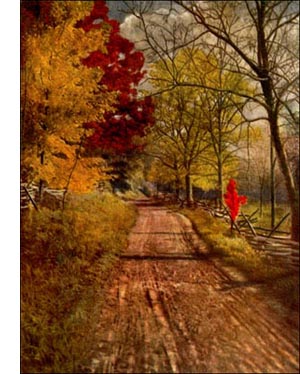Great Rhododendron or Rose Bay Tree
 Great Rhododendron, Rose Bay (Rhododendron maximum, Linn.)-Evergreen shrub or small tree, becoming 35 feet high, with dense, broad head of twisted branches. Bark reddish brown, scaly; branches rusty tomentose at first, becoming greyish.
Great Rhododendron, Rose Bay (Rhododendron maximum, Linn.)-Evergreen shrub or small tree, becoming 35 feet high, with dense, broad head of twisted branches. Bark reddish brown, scaly; branches rusty tomentose at first, becoming greyish.Wood light brown, hard, heavy, fine. Buds scaly, prominent; leaf buds small, axillary, on flowerless branches; flower buds large, conical, terminal. Leaves narrow oblong, tapering to a short petiole; apex abruptly pointed; margin entire, leathery, stiff, dark green, shining above, dull whitish beneath, 4 to 10 inches long.
Flowers, June, in large umbels, on viscid stems; corollas irregular, bell shaped, 5-lobed, 1 1/2 inches across, rosy, purplish or white, with hairy and spotted throat; stamens 8 to 12, curved; pistil simple, with 5-celled ovary and elongated style with 5-lobed red stigma. Fruit a woody, 5-celled many-seeded capsule.
Preferred habitat, sandy, peaty or loamy soil, in somewhat shady situations. Distribution, New Brunswick to Florida; west to Lake Erie, through Gulf States to Louisiana and Arkansas. Mainly along mountains. Rare north of Pennsylvania. Uses: Valuable hardy ornamental evergreen. Forced for winter bloom as potted plants.
Rhododendron means "rose tree" -and we wisely cling to the long, sonorous Greek name. The common English name, rose bay, seems trivial applied to so beautiful a plant. The traveller who visits the southern Appalachian Mountains in early summer sees Rhododendron maximum in its best estate. Above each umbrella-like whorl of glossy evergreen leaves appears a rounded cluster of white or rosy blossoms, dimmed only by the bright green of the new leafy shoots that stand out between the flower clusters. For miles these tree-like growths illuminate the woods, as their shrubby relatives, the azaleas, do in woods farther north. where the rhododendrons dwindle in size and in numbers.
Through late summer the green capsules, each with its curving style atop, mark the place where the blossoms were. They hang on all winter, though the seeds fall in autumn. Against the snow the broad leaves shine brighter than all other evergreens, and a large scaly bud in the centre of the young shoots conceals and promises flowers in profusion for the coming summer.
R. Catawbiense, a more brilliant species in bloom, but always a shrub, is brought by the carload from the high Alleghanies, and planted on great estates in the North, where it passes R. maximum in hardiness. The transplanting of these rhododendrons is accomplished with a loss of scarcely 1 per cent. if done by responsible nurserymen.